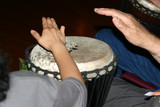Percussion and the Sounds of Nature
One of the most enchanting aspects of world music is the ability to incorporate the sounds of nature into the song. For any person who loves the melody heard while walking through the woods, or that of a quiet sunset on the beach, animals, weather and even the ever-present hum of the earth create an auditory memory that not only recharges, but, can be wholly inspirational.
The inspirational sounds of nature are readily available in many percussion instruments today. These instruments may have once been part of community gatherings and ritual ceremonies, but, they are now some of the more common instruments we hear in a wide range of music. Rain sticks, for example, have found a way into music that is geared toward meditation or that celebrates cultures with a strong attachment to the earth. These instruments were originally made from dried cactus, having the thorns removed and hammered back into the cactus like nails. Then, the hollowed cactus was filled with small stones, pebbles or beans and sealed. By moving the rain stick end-to-end, the materials inside would glide down the inverted thorns, creating a rain-like sound that was used to encourage rain to fall from the sky.
Animal sounds are common in music, as well. The “rattlesnake” sound heard in songs like “Hotel California,” for example, has been attributed to “shakers” like cabasas or shekeres, although, others believe the sound comes from maracas. The guiro is often used in music, creating a “croaking” sound that is likened to that of a frog by running a stick over the ridges of a piece of specially carved wood.
Other percussion instruments that imitate nature's sounds include ocean drums, thunder drums and spring drums. These drums help to recreate the natural sounds we experience through the changing of the seasons or the natural patterns of weather. Of course, for those seeking an authentic, native sound, there is the didgeridoo, an ancient instrument that continues to challenge even the most talented musicians today.
Percussion instruments have the ability to create a wide range of sounds through the different methods of construction, the materials used and the techniques used to create the sounds. As nature is its own source of music, it is no surprise that anything from birds and frogs to the thunder of a hot summer day was the inspiration for creating some of today’s most interesting and beloved musical instruments.
Recent Posts
-
X8 Drums Play-Along Backing Tracks
The new X8 Play-Along Series is being produced for our musician friends wanting a fresh way to work …9th Feb 2025 -
What is the Best Size Djembe for Beginners?
If you're new to the world of percussion and interested in learning the djembe, you're in for a t …16th Jul 2024 -
The Benefits of Becoming a Drumming Teacher: Transforming Passion into Profession
Why become a drumming teacher? Becoming a drumming teacher is an excellent way to share your pas …22nd May 2024



